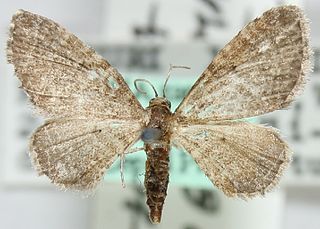
The common pug(Eupithecia vulgata) is a moth of the family Geometridae. It is a common species across the Palearctic region, including the Near East and North Africa. It ranges from the Atlantic coast of Ireland and Portugal across Europe, the Middle East and Central Asia to the Russian Far East (Priamurje) and Korea.

Eupithecia tripunctaria, the white-spotted pug, is a moth of the family Geometridae. The species can be found from Europe to Korea and Japan and in North America.

Eupithecia jezonica is a moth in the family Geometridae. It is found in Asia, including India and Nepal. It has also been recorded from Kazakhstan, the Russian Far East and Korea, Japan and Taiwan.

Eupithecia quadripunctata is a moth in the family Geometridae. It is found in India, Pakistan, Nepal, Russia, China, Taiwan, Korea, Japan and northern Thailand.
Eupithecia subtacincta is a moth in the family Geometridae. It is found in the Himalaya, from Jammu and Kashmir through China to the Russian Far East, Korea and Japan. It is also found from south-east Asia to Borneo.
Eupithecia proterva is a moth in the family Geometridae. It is found in Russia, Japan, Taiwan and Korea.

Eupithecia clavifera is a moth in the family Geometridae. It is found in Russia, China, Japan, Taiwan and Korea.
Eupithecia repentina is a moth in the family Geometridae. It is endemic to eastern Russia, Korea, China and Japan.
Pareupithecia is a genus of moths in the family Geometridae. It contains only one species, Pareupithecia spadix, which is found in the Russian Far East, Korea, Japan (Honshu) and Shanxi, China.
Eupithecia subbreviata is a moth in the family Geometridae. It is found in Russia (Amur), Japan and Korea.
Eupithecia bohatschi is a moth in the family Geometridae first described by Otto Staudinger in 1897. It is found in Tuva, Transbaikalia, the Russian Far East, Mongolia, northern China and Korea.
Eupithecia sophia is a moth in the family Geometridae first described by Arthur Gardiner Butler in 1878. It is found on the Kuriles, in Japan, Korea and western China.
Eupithecia signigera is a moth in the family Geometridae. It is found in Japan and Korea.
Eupithecia supercastigata is a moth in the family Geometridae. It is found in Japan and Korea.

Eupithecia homogrammata is a moth in the family Geometridae. It is found in Russia, Japan and Korea.
Eupithecia consortaria is a moth in the family Geometridae. It is found in Russia, Japan and Korea.

Eupithecia detritata is a moth in the family Geometridae. It is found in the Russian Far East, Japan and Korea.

Eupithecia gigantea is a moth in the family Geometridae. It is found in the Russian Far East, Japan and Korea.
Eupithecia scribai is a moth in the family Geometridae. It is found in the Russian Far East, Japan and Korea.
Eupithecia kobayashii is a moth in the family Geometridae. It is found in Russia, Japan and Korea.







